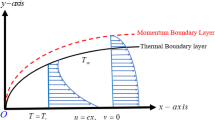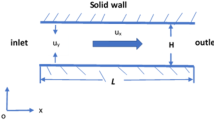Abstract
The nanoscale effects of solid–fluid molecular interactions on the nanoconfined fluid flow have received increasing attention in science and engineering. Additionally, due to the complex microstructures of porous media, the nanoconfined fluid flow behaviors will be more complicated. In this paper, we comprehensively use theoretical analysis and lattice Boltzmann simulations with a new slip curved boundary condition to study the microstructures and molecular interaction effects on nanoconfined water flow. The viscous dissipation rate caused by the entrance effect (streamlines bending), and the nanoscale effects of the slip boundary and the varying interfacial water viscosity caused by molecular interactions are considered and discussed. The results show that the entrance viscous dissipation rate can result in the negative effects near the pore entrance and exit because of the bending streamlines. The increasing entrance viscous dissipation rate can make the enhancement factor approach to 1 by weakening the nanoscale effects. With an increasing contact angle, the entrance viscous dissipation rate causes the main pressure drop and gradually dominates the overall water flow. As nanoscale effects enhance the water flow capacity, the enhancement factor decreases to near 1 with an increasing porous media size because of the decreasing nanoscale effects. As nanoscale effects weaken the water flow capacity, due to the different decreasing effects of the slip length and interfacial water viscosity, the enhancement factor decreases first and then increases to near 1. Our work can guide for studying the oil/water flow in unconventional reservoirs and provide microscopic basics to design artificial nanopores with excellent performance.


















Similar content being viewed by others
References
Ajarostaghi, S.S.M., Delavar, M.A., Poncet, S.: Thermal mixing, cooling and entropy generation in a micromixer with a porous zone by the lattice Boltzmann method. J. Therm. Anal. Calorim. 140(3), 1321–1339 (2020)
Ansumali, S., Karlin, I.V., 2002. Kinetic boundary conditions in the lattice Boltzmann method. Physical Review E 66, 026311.
Bouzidi, M., Firdaouss, M., Lallermand, P.: Momentum transfer of a lattice Boltzmann fluidwith boundaries. Phys. Fluids 13, 3452–3459 (2001)
Farrokhpanah, A., Nabovati, A., Mostaghimi, J.: Study of curved boundary treatments in lattice Boltzmann method. In: Proceedings of The Canadian Society for Mechanical Engineering International Congress (2014)
Filippova, O., Hänel, D.: Grid refinement for lattice-BGK models. J. Comput. Phys. 147, 219–228 (1998)
Golparvar, A., Zhou, Y., Wu, K., Ma, J., Yu, Z.: A comprehensive review of pore scale modeling methodologies for multiphase flow in porous media. Adv. Geo-Energy Res. 2(4), 418–440 (2018)
Gravelle, S., Joly, L., Detcheverry, F., Ybert, C., Cottin-Bizonne, C., Bocquet, L.: Optimizing water permeability through the hourglass shape of aquaporins. Proc. Natl. Acad. Sci. 201306447 (2013)
Gravelle, S., Joly, L., Ybert, C., Bocquet, L.: Large permeabilities of hourglass nanopores: from hydrodynamics to single file transport. J. Chem. Phys. 141, 18C526 (2014)
Gravelle, S., Ybert, C., Bocquet, L., Joly, L.: Anomalous capillary filling and wettability reversal in nanochannels. Phys. Rev. E 93, 033123 (2016)
Guo, Z., Shi, B., Zhao, T., Zheng, C.: Discrete effects on boundary conditions for the lattice Boltzmann equation in simulating microscale gas flows. Phys. Rev. E 76, 056704 (2007)
Guo, Z., Shi, B., Zheng, C.: Velocity inversion of micro cylindrical Couette flow: a lattice Boltzmann study. Comput. Math. Appl. 61, 3519–3527 (2011)
Guo, Z., Zheng, C., Shi, B.: Discrete lattice effects on the forcing term in the lattice Boltzmann method. Phys. Rev. E 65, 046308 (2002)
He, J., Ju, Y., Lammers, L., Kulasinski, K., Zheng, L.: Tortuosity of kerogen pore structure to gas diffusion at molecular-and nano-scales: a molecular dynamics simulation. Chem. Eng. Sci. 215, 115460 (2020)
He, X., Luo, L.-S.: A priori derivation of the lattice Boltzmann equation. Phys. Rev. E 55, R6333 (1997)
He, X., Zou, Q., Luo, L.-S., Dembo, M.: Analytic solutions of simple flows and analysis of nonslip boundary conditions for the lattice Boltzmann BGK model. J. Stat. Phys. 87, 115–136 (1997)
Huang, D.M., Sendner, C., Horinek, D., Netz, R.R., Bocquet, L.: Water slippage versus contact angle: a quasiuniversal relationship. Phys. Rev. Lett. 101, 226101 (2008)
Huang, J., Hu, Z., Yong, W.-A.: Second-order curved boundary treatments of the lattice Boltzmann method for convection–diffusion equations. J. Comput. Phys. 310, 26–44 (2016)
Kannam, S.K., Todd, B.D., Hansen, J.S., Daivis, P.J.: How fast does water flow in carbon nanotubes? J. Chem. Phys. 138, 094701 (2013)
Köhler, M.H., Bordin, J.R., de Matos, C.F., Barbosa, M.C.: Water in nanotubes: the surface effect. Chem. Eng. Sci. 203, 54–67 (2019)
Mattia, D., Calabrò, F.: Explaining high flow rate of water in carbon nanotubes via solid–liquid molecular interactions. Microfluid. Nanofluid. 13, 125–130 (2012)
Mei, R., Luo, L.-S., Shyy, W.: An accurate curved boundary treatment in the lattice Boltzmann method. In: 14th Computational Fluid Dynamics Conference, p. 3353 (2000)
Neek-Amal, M., Peeters, F.M., Grigorieva, I.V., Geim, A.K.: Commensurability effects in viscosity of nanoconfined water. ACS Nano 10, 3685–3692 (2016)
Nie, X., Doolen, G.D., Chen, S.: Lattice-Boltzmann simulations of fluid flows in MEMS. J. Stat. Phys. 107, 279–289 (2002)
Rabbani, A., Mostaghimi, P., Armstrong, R.T.: Pore network extraction using geometrical domain decomposition. Adv. Water Resour. 123, 70–83 (2019)
Roscoe, R.: XXXI. The flow of viscous fluids round plane obstacles. Philos. Mag. Ser. 1 40, 338–351 (1949)
Sampson, R.A.: XII. On Stokes’s current function. Philos. Trans. R. Soc. Lond. (A.) 449–518 (1891)
Sanhai, W.R., Sakamoto, J., Canady, R., Ferrari, M.: Seven challenges for nanomedicine. Nat. Nanotechnol. 3, 242–244 (2008)
Shaat, M.: Viscosity of water interfaces with hydrophobic nanopores: application to water flow in carbon nanotubes. Langmuir 33, 12814–12819 (2017)
Shin, S., Kim, A.-R., Um, S.: Computational prediction of nanoscale transport characteristics and catalyst utilization in fuel cell catalyst layers by the lattice Boltzmann method. Electrochim. Acta 275, 87–99 (2018)
Succi, S.: Mesoscopic modeling of slip motion at fluid-solid interfaces with heterogeneous catalysis. Phys. Rev. Lett. 89, 064502 (2002)
Szalmás, L.: Slip-flow boundary condition for straight walls in the lattice Boltzmann model. Phys. Rev. E 73, 066710 (2006)
Tang, G., Tao, W., He, Y.: Lattice Boltzmann method for gaseous microflows using kinetic theory boundary conditions. Phys. of Fluids 17, 058101 (2005)
Tao, S., Chen, B., Xiao, H., Huang, S.: Lattice Boltzmann simulation of thermal flows with complex geometry using a single-node curved boundary condition. Int. J. Therm. Sci. 146, 106112 (2019)
Tao, S., Guo, Z.: Boundary condition for lattice Boltzmann modeling of microscale gas flows with curved walls in the slip regime. Phys. Rev. E 91, 043305 (2015)
Tao, S., He, Q., Chen, B., Yang, X., Huang, S.: One-point second-order curved boundary condition for lattice Boltzmann simulation of suspended particles. Comput. Math. Appl. 76, 1593–1607 (2018)
Tao, S., Zhang, H., Guo, Z.: Drag correlation for micro spherical particles at finite Reynolds and Knudsen numbers by lattice Boltzmann simulations. J. Aerosol Sci. 103, 105–116 (2017)
Thomas, J.A., McGaughey, A.J.: Reassessing fast water transport through carbon nanotubes. Nano Lett. 8, 2788–2793 (2008)
Tocci, G., Joly, L., Michaelides, A.: Friction of water on graphene and hexagonal boron nitride from ab initio methods: very different slippage despite very similar interface structures. Nano Lett. 14, 6872–6877 (2014)
Wang, H., Su, Y., Zhao, Z., Wang, W., Sheng, G., Zhan, S.: Apparent permeability model for shale oil transport through elliptic nanopores considering wall-oil interaction. J. Petroleum Sci. Eng. (2019a)
Wang, H., Su, Y., Wang, W., Sheng, G., Li, H., Zafar, A.: Enhanced water flow and apparent viscosity model considering wettability and shape effects. Fuel 253, 1351–1360 (2019b)
Wang, H., Su, Y., Wang, W., Sheng, G.: Hydrodynamic resistance model of oil flow in nanopores coupling oil–wall molecular interactions and the pore-throat structures effect. Chem. Eng. Sci. 115166 (2019c)
Wang, K., Chai, Z., Hou, G., Chen, W., Xu, S.: Slip boundary condition for lattice Boltzmann modeling of liquid flows. Comput. Fluids 161, 60–73 (2018)
Wang, S., Javadpour, F., Feng, Q.: Fast mass transport of oil and supercritical carbon dioxide through organic nanopores in shale. Fuel 181, 741–758 (2016)
Wang, S., Javadpour, F., Feng, Q.: Molecular dynamics simulations of oil transport through inorganic nanopores in shale. Fuel 171, 74–86 (2016)
Wang, S., Han, X., Dong, Y., Shi, H.: Mechanisms of reservoir pore/throat characteristics evolution during long-term waterflooding. Adv. Geo Energy Res. 1(3), 148–157 (2017)
Warner, N.R., Jackson, R.B., Darrah, T.H., Osborn, S.G., Down, A., Zhao, K., White, A., Vengosh, A.: Geochemical evidence for possible natural migration of Marcellus Formation brine to shallow aquifers in Pennsylvania. Proc. Natl. Acad. Sci. 109, 11961–11966 (2012)
Wu, K., Chen, Z., Li, J., Xu, J., Wang, K., Li, R., Wang, S., Dong, X.: Ultrahigh water flow enhancement by optimizing nanopore chemistry and geometry. Langmuir 35, 8867–8873 (2019)
Wu, K., Chen, Z., Li, J., Lei, Z., Xu, J., Wang, K., Li, R., Dong, X., Peng, Y., Yang, S.: Nanoconfinement effect on n-alkane flow. J. Phys. Chem. C 123, 16456–16461 (2019)
Wu, K., Chen, Z., Li, J., Li, X., Xu, J., Dong, X.: Wettability effect on nanoconfined water flow. Proc. Natl. Acad. Sci. 114, 3358–3363 (2017)
Yang, L., Yu, Y., Hou, G., Wang, K., Xiong, Y.: Boundary conditions with adjustable slip length for the lattice Boltzmann simulation of liquid flow. Comput. Fluids 174, 200–212 (2018)
Yu, D., Mei, R., Shyy, W.: A unified boundary treatment in lattice Boltzmann method. In: 41st Aerospace Sciences Meeting and Exhibit, p. 953 (2003)
Yu, Y., Liang, D., Liu, H.: Lattice Boltzmann simulation of immiscible three-phase flows with contact-line dynamics. Phys. Rev. E 99, 013308 (2019)
Zachariah, G.T., Panda, D., Surasani, V.K.: Lattice Boltzmann simulations for invasion patterns during drying of capillary porous media. Chem. Eng. Sci. 196, 310–323 (2019)
Zeng, F., Zhang, Q., Guo, J., Meng, Y., Shao, X., Zheng, Y.: Capillary imbibition of confined water in nanopores. Capillarity 3(1), 8–15 (2020)
Zhan, S., Su, Y., Jin, Z., Zhang, M., Wang, W., Hao, Y., Li, L.: Study of Liquid-liquid two-phase flow in hydrophilic nanochannels by molecular simulations and theoretical modeling. Chem. Eng. J. 125053 (2020)
Zhang, L., Jing, W., Yang, Y., Yang, H., Guo, Y., Sun, H., Zhao, J., Yao, J.: The investigation of permeability calculation using digital core simulation technology. Energies 12(17), 3273 (2019)
Zhang, Q., Su, Y., Wang, W., Lu, M., Sheng, G.: Apparent permeability for liquid transport in nanopores of shale reservoirs: Coupling flow enhancement and near wall flow. Int. J. Heat Mass Transf. 115, 224–234 (2017)
Zhang, T., Li, X., Sun, Z., Feng, D., Miao, Y., Li, P., Zhang, Z.: An analytical model for relative permeability in water-wet nanoporous media. Chem. Eng. Sci. 174, 1–12 (2017)
Zhao, J., Kang, Q., Wang, Y., Yao, J., Zhang, L., Yang, Y.: Viscous dissipation and apparent permeability of gas flow in nanoporous media. J. Geophys. Res. Solid Earth 125(2), e2019JB018667
Zhao, J., Kang, Q., Yao, J., Zhang, L., Li, Z., Yang, Y., Sun, H.: Lattice Boltzmann simulation of liquid flow in nanoporous media. Int. J. Heat Mass Transf. 125, 1131–1143 (2018)
Acknowledgements
This study was supported by National Natural Science Foundation of China (51974348, 51804328), The National Science and Technology Major Project of China (ZD2019-183-007), Shandong Province Natural Science Foundation (ZR2018BEE008, ZR2018BEE018), Fundamental Research Funds for the Central Universities (18CX02168A), and Graduate Innovative Engineering project (YCX2020023).
Author information
Authors and Affiliations
Corresponding author
Additional information
Publisher's Note
Springer Nature remains neutral with regard to jurisdictional claims in published maps and institutional affiliations.
Rights and permissions
About this article
Cite this article
Wang, H., Su, Y., Qiao, R. et al. Investigate Effects of Microstructures on Nanoconfined Water Flow Behaviors from Viscous Dissipation Perspectives. Transp Porous Med 140, 815–836 (2021). https://doi.org/10.1007/s11242-021-01614-1
Received:
Accepted:
Published:
Issue Date:
DOI: https://doi.org/10.1007/s11242-021-01614-1




